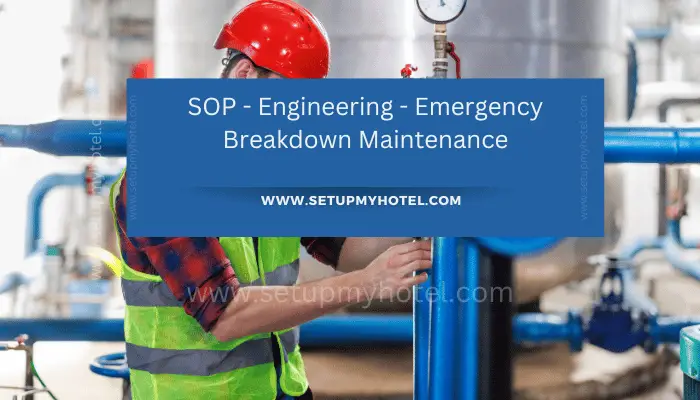Engineering Breakdown Maintenance Procedure
In any engineering operation, it is important to have a standard operating procedure (SOP) in place for emergency breakdown maintenance. This ensures that the necessary steps are taken promptly and efficiently to minimize downtime and maintain safety.
The first step in the SOP is to identify the nature and severity of the breakdown. This can be done through equipment monitoring, regular inspections, and analysis of performance data. Once the problem has been identified, the next step is to isolate the affected equipment to prevent further damage or accidents.
The maintenance team should then be notified immediately to carry out the necessary repairs or replacements. The team should be well-trained and equipped with the necessary tools and spare parts to carry out the job effectively.
During the maintenance process, safety should be a top priority. The team should follow all safety protocols and ensure that all necessary precautions are taken to prevent accidents or injuries.
Once the repairs have been completed, the equipment should be tested to ensure that it is functioning properly. If necessary, further adjustments or repairs should be made until the equipment is fully operational.
Finally, a post-maintenance inspection should be carried out to ensure that the equipment is in good working condition and that there are no further issues. This will help to prevent future breakdowns and ensure that the equipment functions efficiently and safely.
Breakdown Maintenance Standard Procedure:
- Breakdown maintenance is an un-schedule maintenance
- Information received about the breakdown is entered in the breakdown register and assigned to a technician.
- The technician with his toolkit goes to the site and analyzes the cause of the breakdown.
- After analyzing the fault he intimates to the concerned department how much time he will take to repair it.
- The technician may call for additional help if required.
- Technicians try to repair the damaged part if possible.
- If any spare parts are required the same is issued from the store.
- After changing spare parts, he starts the machine and checks it thoroughly.
- If the machine is working fine then they inform the concerned department again that the machine is okay now.
- The record of the maintenance activity is updated on the register.
- At a frequency of two months, break-down data is analyzed to find repetitive failures.
- Additional notes are taken on where failures are taking place.
- Based on the analysis necessary actions are initiated to reduce the occurrence of breakdown.
- Wherever required preventive maintenance schedule and/or checklist is modified.
- Based on the previous cases or history frequently required spare parts to be identified for key equipment.
- Details of frequently required parts are given to stores to maintain the minimum inventory.
- Based on the breakdown analysis the below sheet is to be updated as required.
Breakdown Maintenance Standard Procedure:
- Breakdown maintenance is an un-schedule maintenance
- Information received about a breakdown is entered in the breakdown register and assigned to a technician.
- The technician with his toolkit goes to the site and analyzes the cause of the breakdown.
- After analyzing the fault he intimates to the concerned department how much time they will take to repair it.
- The technician may call for additional help if required.
- The technician try to repair the damaged part if possible.
- If any spare parts are required the same is issued from the store.
- After changing spare parts, he starts the machine and checks it thoroughly.
- If the machine is working fine then they inform the concerned department again that the machine is okay now.
- The record of the maintenance activity is updated on the register.
- At a frequency of two months, break-down data is analyzed to find repetitive failures.
- Additional notes are taken on where failures are taking place.
- Based on the analysis necessary actions are initiated to reduce the occurrence of breakdown.
- Wherever required preventive maintenance schedule and/or checklist is modified.
- Based on the previous cases or history frequently required spare parts to be identified for key equipment.
- Details of frequently required parts are given to stores to maintain the minimum inventory.
- Based on the breakdown analysis the below sheet is to be updated as required.
Breakdown Analysis Tracking Sheet
| Date | Time of Breakdown | Time of Handover | Equipment | Details of Breakdown | Details of Repair Done | Technician Remark | Name | Signature |
Training Summary questions:
Training Questions:
- Why is it crucial to calibrate instruments regularly?
- What does the SOP recommend in terms of the frequency of instrument calibration?
- Who is responsible for performing the calibration according to the SOP?
- Explain the significance of maintaining a master list for instruments and how it aids in the calibration process.
- In case an instrument is found out of calibration, what steps does the SOP suggest taking, and who is involved in the process?
- Describe the information included in the Calibration Card/Sticker.
- What should be checked upon receiving the calibration certificate for an instrument?
- Why is it important to provide training to users on the safe handling and storage of instruments?
- How does the SOP suggest handling instruments found out of calibration, and what actions may be taken, including changes in calibration frequency?
- Explain the purpose of the calibration sticker or card on the instrument.
- What are the potential consequences of using instruments that are not regularly calibrated?
- Provide an example of a situation where an instrument may need its calibration frequency adjusted based on calibration results.
- How does the SOP recommend ensuring traceability to the national standard in the calibration process?
Patreon Only SOP Download
SOP Number: Hotel Engineering SOP – 23
Department: Engineering and Maintenance
Date Issued: 08–Mar-2018
Time to Train: 25 Minutes












